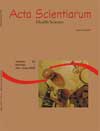<b>Study into the HBsAg seroprevalence in pregnant women from the 15<sup>th </sup> Health Regional and the immunoprophylaxia on the newborns of these HBsAg-positive women</b> - DOI: 10.4025/actascihealthsci.v30i1.4394
Keywords:
hepatitis B, HBsAg, immunoprophylaxis, CRIE, pregnant women, seroprevalence
Abstract
To determine HBsAg prevalence among pregnant women from the 15th Health Regional assisted in the Laboratório de Ensino e Pesquisa em Análises Clínicas (Lepac), Universidade Estadual de Maringá, and verify whether immunoprophylaxis with vaccine and immunoglobulin was requested for the newborns of HBsAg-positive women during the period from January 1998 to December 2002. The research about HBsAg was conducted using the immunoenzymatic IMxHBsAg (Abbot Lab) and Axsym HBsAg (Abbot Lab) techniques. The requests to the CRIE for special immunobiologic agents for Hepatitis B immunoprophylaxis were obtained in the Department of Epidemiology from the 15th Health Regional. The analysis includes 12,274 pregnant women, and the HBsAg prevalence was 1.0%. Among 125 HBsAg positive pregnant women, immunoprophylaxis was requested for 32 (25.6%) newborns. Although the prevalence detected demonstrates this to be a low endemic area, the results evidence the importance of conducting the hepatitis B diagnostic during prenatal assistance, in order to perform immunoprophylaxis on the newborns.Downloads
Download data is not yet available.
Published
2008-07-24
How to Cite
Bertolini, D. A., & Miyamoto, S. K. (2008). <b>Study into the HBsAg seroprevalence in pregnant women from the 15<sup>th </sup> Health Regional and the immunoprophylaxia on the newborns of these HBsAg-positive women</b> - DOI: 10.4025/actascihealthsci.v30i1.4394. Acta Scientiarum. Health Sciences, 30(1), 1-6. https://doi.org/10.4025/actascihealthsci.v30i1.4394
Issue
Section
Clinical Analysis
DECLARATION OF ORIGINALITY AND COPYRIGHTS
I Declare that current article is original and has not been submitted for publication, in part or in whole, to any other national or international journal.
The copyrights belong exclusively to the authors. Published content is licensed under Creative Commons Attribution 4.0 (CC BY 4.0) guidelines, which allows sharing (copy and distribution of the material in any medium or format) and adaptation (remix, transform, and build upon the material) for any purpose, even commercially, under the terms of attribution.
Read this link for further information on how to use CC BY 4.0 properly.























5.png)







